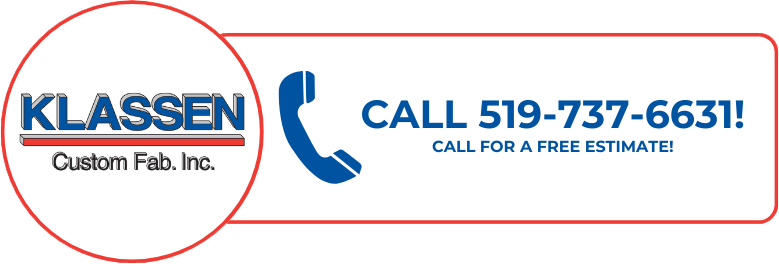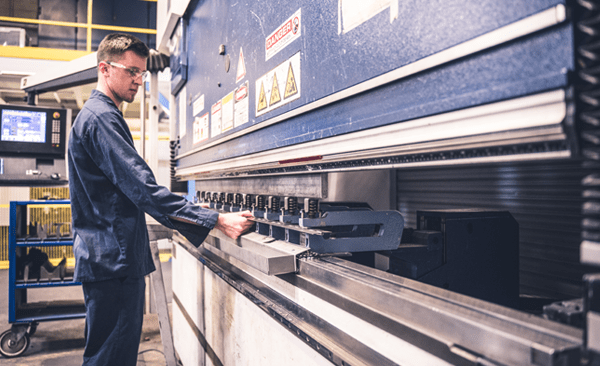Metal forming stands as a key process in manufacturing and industrial sectors. This guide explains the basics of metal forming, its types, applications, and benefits for your projects. Klassen Custom Fabricating offers these services in Windsor, Ontario with certified expertise and advanced technology.
What Is Metal Forming?
Metal forming changes the shape of metal workpieces without adding or removing material. This process alters the physical geometry while maintaining the material’s mass and composition. Metal forming creates parts for various industries including automotive, construction, electronics, and aerospace.
The Science Behind Metal Forming
Metal forming works because of metal plasticity – the ability of metals to deform permanently without breaking. When force exceeds the metal’s yield strength, the metal flows into new shapes. This property allows manufacturers to create complex components from simple metal stock.
Common Metal Forming Methods
Sheet Metal Forming
Sheet metal forming transforms flat metal sheets into parts. This process suits many products from simple brackets to complex enclosures.
Bending
Bending creates angles in metal sheets. Press brakes push metal against dies to form precise angles. This technique makes parts for electrical enclosures, brackets, and frames. Klassen Custom Fabricating uses advanced bending equipment for accurate results.
Drawing
Drawing pulls sheet metal into a die cavity to form cup-shaped parts. This method produces parts like beverage cans, automotive body panels, and sink basins. The process requires careful control to prevent tearing or wrinkling.
Stamping
Stamping uses dies to cut and form sheet metal in a single operation. A press forces the metal into the die, creating the desired shape. This high-speed process suits high-volume production of parts like automotive components and appliance parts.
Bulk Metal Forming
Bulk forming processes work with thicker metal sections and often involve significant deformation.
Forging
Forging compresses metal between dies using hammers or presses. This creates strong parts with excellent grain structure. Forged parts include engine components, hand tools, and structural elements. The process improves material strength through grain refinement.
Extrusion
Extrusion forces metal through a die opening to create long parts with constant cross-sections. This process makes products like aluminum window frames, pipes, and railings. Extrusion can produce complex shapes that would be difficult to make with other methods.
Rolling
Rolling passes metal between rotating rolls to reduce thickness and increase length. This creates sheets, plates, and structural shapes like I-beams and rails. Rolling improves material properties and surface finish.
Materials Used in Metal Forming
Steel
Steel remains the most common metal for forming operations. Its combination of strength, formability, and cost makes it ideal for many applications. Steel types include:
- Mild steel for general applications
- High-strength steel for structural components
- Stainless steel for corrosion resistance
Klassen Custom Fabricating works with various steel types to meet customer requirements for strength and durability.
Aluminum
Aluminum offers light weight and good corrosion resistance. It forms easily and suits applications where weight matters. Common uses include automotive components, aerospace parts, and packaging.
Stainless Steel
Stainless steel combines excellent corrosion resistance with good mechanical properties. It forms electrical enclosures, food processing equipment, and medical devices. Klassen Custom Fabricating specializes in stainless steel fabrication for demanding applications.
Other Metals
Copper, brass, titanium, and specialty alloys also undergo forming processes for specific applications. Each material requires specific forming methods and conditions.
Advanced Metal Forming Technologies
Laser Cutting
Laser cutting uses focused light beams to cut precise shapes from metal sheets. This technology offers high accuracy and clean edges. Klassen Custom Fabricating uses laser cutting for complex parts with tight tolerances.
Hydroforming
Hydroforming uses fluid pressure to shape metal against a die. This process creates complex shapes from tubes or sheets. It produces lightweight, strong parts for automotive and aerospace applications.
Computer Numerical Control (CNC)
CNC systems automate metal forming equipment for consistent results. These systems improve accuracy and reduce setup time. Modern shops use CNC for most forming operations.
Benefits of Custom Metal Forming
Design Freedom
Custom metal forming allows engineers to create parts that match exact specifications. This freedom helps optimize products for performance and cost. Klassen Custom Fabricating works with customers to develop designs that meet their needs.
Material Efficiency
Metal forming wastes less material than machining processes. This efficiency reduces costs and environmental impact. The process uses material more effectively by reshaping rather than removing it.
Structural Integrity
Formed metal parts often have better strength than machined parts. The forming process can improve material grain structure and mechanical properties. This advantage matters for structural components.
Cost-Effectiveness
For appropriate applications, metal forming costs less than alternative manufacturing methods. High production volumes especially benefit from forming processes. The initial tooling investment pays off through faster production cycles.
Applications in Various Industries
Manufacturing Equipment
Metal forming creates components for production machinery. These parts include frames, guards, and enclosures. Klassen Custom Fabricating builds custom machine guards and enclosures to protect workers and equipment.
Automotive Components
The automotive industry uses formed metal parts throughout vehicles. Components include body panels, chassis parts, and brackets. Metal forming delivers the strength and lightweight properties needed for modern vehicles.
Construction Elements
Construction projects use formed metal for structural and decorative elements. Products include beams, railings, and architectural features. These components combine strength with visual appeal.
Electrical Systems
Electrical enclosures protect sensitive components from damage. Custom formed enclosures fit exact space requirements while meeting safety standards. Klassen Custom Fabricating builds electrical enclosures to CSA and UL standards.
Choosing a Metal Forming Partner
Technical Capability
Look for companies with appropriate equipment and expertise. The right partner can handle your specific requirements. Klassen Custom Fabricating maintains advanced equipment for various forming operations.
Quality Standards
ISO certification indicates commitment to quality processes. Certified companies follow documented procedures for consistent results. Klassen Custom Fabricating holds ISO 9001 certification, ensuring quality management systems.
Service Range
Companies offering design through installation provide seamless project execution. This comprehensive approach reduces coordination issues. Klassen Custom Fabricating offers complete services from design to installation.
Experience
Experienced fabricators solve problems more effectively. They anticipate issues before they affect your project. Look for companies with a track record in your industry.
The Metal Forming Process
Design Phase
Projects start with clear design specifications. Engineers convert concepts into detailed plans. Klassen Custom Fabricating helps customers refine designs for manufacturability.
Material Selection
The right material balances performance and cost. Experts select appropriate metals based on application requirements. Factors include strength, corrosion resistance, and formability.
Tooling Preparation
Custom forming often requires specialized tooling. Dies and fixtures ensure accurate, repeatable results. This preparation stage affects final part quality.
Production
Modern production combines automated equipment with skilled oversight. Quality checks occur throughout the process. Klassen Custom Fabricating maintains strict quality control during production.
Finishing Operations
Formed parts often need additional processes like welding, painting, or powder coating. These operations complete the parts for their intended use. Klassen Custom Fabricating offers custom welding and coating services.
Future Trends in Metal Forming
Simulation and Modeling
Computer simulation predicts forming behavior before production starts. This capability reduces trial and error in development. Modern design software improves first-time success rates.
Advanced Materials
New alloys and composites expand forming possibilities. These materials offer improved properties for demanding applications. The forming industry continues to adapt to these new materials.
Automation and Integration
Increasing automation improves consistency and reduces labor costs. Integrated systems connect design directly to production equipment. This trend makes metal forming more efficient.
Contact Klassen Custom Fabricating Today For Expert Metal Forming Solutions
Metal forming plays an essential role in modern manufacturing. The process creates parts ranging from simple brackets to complex assemblies. For successful projects, choose experienced partners like Klassen Custom Fabricating who understand metal forming principles and applications. With the right approach, metal forming delivers cost-effective, high-quality components for your industrial and manufacturing needs.


Share This Article
Choose Your Platform: Facebook Twitter Google Plus Linkedin